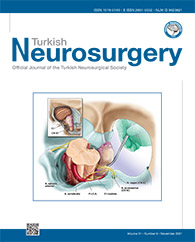2Kirikkale University, Faculty of Medicine, Department of Pathology, Kirikkale, Turkey
3Yenimahalle Training and Research Hospital, Neurosurgery Clinic, Ankara, Turkey DOI : 10.5137/1019-5149.JTN.31128-20.2 AIM: To create an alternative synthetic dural graft using a parenteral solution bag made of polyvinyl chloride/polypropylene (PVC/ PP).
MATERIAL and METHODS: Twenty-two albino rats were divided into the Sham, DC and BAG groups. Except for the Sham group animals, the right parietal bone of the rats was totally drilled in a diameter of 1.0 x 0.5 mm. Then, the PVC/PP BAG was layered over the craniectomized bone of the BAG group animals. Thirty days later, all animals were sacrificed, and inflammatory processes consisting of polymorphonuclear cell infiltration, inflammation, edema, hyperemia, lymphocytosis, histiocytosis, vascular proliferation, and fibrosis were graded at the craniectomy site.
RESULTS: The grade values of inflammation, edema, histiocytosis, and fibrosis were found different among the groups (p<0.017). It was observed that placing a synthetic graft to the surgical site undergoing craniectomy could prevent fibrotic adhesions that might occur between the brain tissue and scalp in the chronic period. Furthermore, it was considered that this synthetic material did not increase inflammatory processes secondary to surgery at the surgical site and did not produce a foreign body reaction, toxicity, or infection.
CONCLUSION: As a result of this study, it was argued that the synthetic material used in this study could be compatible with dermal and neural tissues and reduce adhesions at the craniectomy field. Therefore, it was considered that this material could be used as an alternative synthetic dural graft in decompressive craniectomy in human subjects after detailed toxicity studies.
Keywords : Bogota bag, Decompressive craniectomy, Fibrosis, Dural graft, Synthetic




